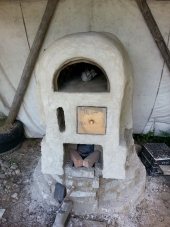


Consider - the smaller the rocket, the more time it'll have to burn. And smaller rockets take more tending.Alexis Hamels wrote:Thanks for all the answers so far.
It becomes clearer to me what I need to do.
I'll take the information to a local stove-builder and see what comes out of it.
The wall is made of red brick. I suppose it conducts the heat well, so that it radiates on both sides. That's what I wanted to make sure.
Another concern is how much fuel it would need. I definitly don't want to have to feed it all day long.
As a nice first job, I should problably best build a small standard rocket stove and experiment with it. I can see that now.



Byron Campbell wrote:Yes I believe you've got a good handle on it Rob. The way the system is described in "the book", the two barrels are joined by their ends that would normally accept their removable lids (joined lip to lip with the standard barrel band clamp). So in your application one option would be to cut your top barrel to length with clamping end intact. Then close the cut end with a welded on lid, or even make one from a disk of heavier gauge steel for a nice heavy cook surface.
Here's another idea that may help you avoid the welding chore. Common 55 gal. drums have two molded in strengthening or stiffening bulges encircling their circumference, one at about 1/3 the barrels length and the other at about the 2/3 point. If the barrel was shortened by cutting it at the apex of one of those molded in bulges it would make for a nicely flared opening to facilitate clamping to the other barrels lip. Best to try this out first with a scrap barrel.
As to the gasket to seal the two barrel sections together, Wisner mentions using fiberglass woodstove door gasket, high heat foil tape, then the original ring clamp (band clamp).


